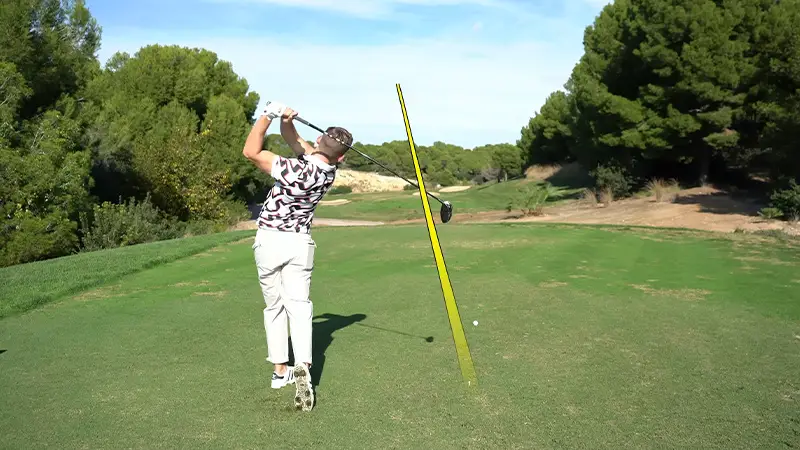Many golfers, from beginners to seasoned pros, grapple with the challenge of achieving a consistent swing. The common misconception is that faster swings translate to greater distance.
However, this often leads to hooks, slices, and overall inconsistency. As one pro golfer wisely said, “Hitting it crooked is no way to go through life.”
Slowing down your golf swing can be a game-changer, leading to better contact and straighter shots. In today’s Play Smart column, golf instructor Paul Wilson shares valuable tips on how to reduce swing aggressiveness and find better balance.
By mastering the art of a controlled swing, players can improve their accuracy and enjoy a more reliable game.
Understanding the Importance of Swing Tempo
Swing tempo serves as the foundation for a successful golf swing, significantly influencing a player’s performance. Central to mastering swing tempo is realizing why slower can often be better.
Why Slower Can Be Better
A slower swing tempo not only enhances control but also reduces the margin for error during a golf swing. Controlled swings lead to consistent ball contact, minimizing mishits such as hooks and slices. Professional golfers like Steve Stricker and Nick Price exemplify this principle.
Stricker’s decision to slow down his swing resulted in remarkable improvements in consistency and accuracy, while Price’s adjustment led to multiple major championships.
Moreover, a deliberate swing tempo mitigates tension and anxiety. Golfers frequently rush swings due to the desire to see immediate results, often resulting in poor execution.
By embracing a slower swing, players foster relaxation and improve muscle coordination, which enhances both accuracy and distance.
Impact of Tempo on Accuracy and Distance
Swing tempo plays a critical role in determining both accuracy and distance. Annika Sörenstam, a legendary LPGA golfer, focused on maintaining a steady tempo with her coach, leading to numerous victories.
A well-measured swing provides a golfer with better control over the club’s path, ensuring the ball travels in the intended direction.
A controlled tempo doesn’t diminish power; rather, it optimizes it. When focusing on a slower tempo, golfers can generate sufficient power through proper timing and coordination.
This approach leads to not only longer but also straighter shots. Therefore, mastering swing tempo is indispensable for golfers at any skill level, significantly enhancing overall performance on the course.
Preparing to Slow Down Your Swing
Slowing down the golf swing provides numerous advantages that improve consistency and accuracy. Begin by understanding your current swing and selecting the right equipment.
Assessing Your Current Swing Speed
Measure the existing swing speed to identify where to make adjustments. Use a launch monitor or a speed radar device for accuracy. Start by recording a series of swings to establish a baseline. Review the recorded data and note the average speed.
This information reveals whether a slower tempo aligns better with your natural rhythm. Observe Steve Stricker’s example, where reducing swing speed significantly improved his control and ball-striking consistency.
Equipment Considerations
Evaluate the golf equipment to find optimal tools for a slower swing. Start with the club’s shaft flex; a softer flex may support better control.
Adjust the club’s loft if necessary, as higher lofts can generate more forgiving ball flights. Consider the ball type also; certain models are designed to perform well at lower swing speeds.
Nick Price’s choice to modify his equipment in line with a slower swing tempo contributed to his major championship wins. Swing mechanics are equally important.
Focus on a smooth, rhythmic transition from backswing to downswing. Practice drills aimed at maintaining balance and reducing tension.
Fundamental Techniques to Reduce Swing Speed
Reducing swing speed improves accuracy and consistency in golf. Employing specific techniques can aid in achieving a smoother and more controlled swing.
The Role of Grip Pressure
Grip pressure significantly affects swing tempo. Ensure the grip remains firm yet relaxed. A tense grip often leads to rushed swings.
By maintaining relaxed hands, fluidity in the club’s motion enhances. This also decreases the likelihood of jerky, rapid movements.
Additionally, focusing on a smooth transition from the backswing to the downswing can further aid in slowing down the golf swing.
By maintaining relaxed hands, fluidity in the club’s motion enhances. This also decreases the likelihood of jerky, rapid movements.
Additionally, focusing on a smooth transition from the backswing to the downswing can further aid in slowing down the golf swing.
Consistent practice with slow, deliberate swings helps train muscle memory, resulting in a more controlled and measured game. Remember, patience and focus are key elements in mastering a relaxed, effective swing.
Controlled Breathing Techniques
Incorporating breathing techniques calms the mind and body. Deep, measured breaths before each shot help in slowing down an overly fast swing.
Inhale slowly through the nose and exhale through the mouth. This practice oxygenates muscles and induces a calm state, promoting a more controlled swing.
Additionally, focusing on a consistent rhythm can further aid in maintaining a steady pace. Visualize a smooth, fluid motion while keeping a natural tempo, ensuring a balanced and deliberate swing.
Visualization Tactics
Visualization plays a crucial role in achieving the desired swing. Before taking a shot, close the eyes and imagine the perfect swing from start to finish.
Focus on the fluid motion, the sensation of the club, and the sound of the ball being struck. This mental rehearsal imprints the desired rhythm and increases the likelihood of replicating it during the actual swing.
on the mind, effectively enhancing muscle memory. By practicing visualization regularly, golfers can train their bodies to maintain a more controlled and consistent tempo, ultimately improving their game.
Drills to Practice Slower Swings
Integrating specific drills into practice sessions assists golfers in slowing their swing tempo and enhancing accuracy.
The Half-Speed Swing Drill
The Half-Speed Swing Drill encourages golfers to swing at half their normal speed. This technique helps refine swing mechanics without the pressure of generating full power.
Start by taking normal practice swings, then consciously reduce the speed by 50%. Focus on maintaining balance, proper form, and follow-through.
Over time, this drill conditions the muscles to achieve a smooth, controlled motion. By incorporating this drill into regular practice sessions, golfers can develop a more consistent and accurate swing.
Additionally, slowing down the swing allows for better feedback on any flaws or misalignments, making it easier to correct them.
This method not only enhances muscle memory but also reduces the likelihood of injury, promoting longevity in the sport.
The Pause-at-the-Top Drill
The Pause-at-the-Top Drill emphasizes pausing at the top of the backswing. Pause for 2-3 seconds before initiating the downswing.
This deliberate pause prevents rushing and ensures a more deliberate transition. It also provides an opportunity to check alignment and balance.
Perform this drill repeatedly to build consistency and enhance timing without feeling rushed. Additionally, practicing this drill can improve muscle memory and overall swing mechanics.
By incorporating these structured pauses into your routine, you can achieve a smoother, more controlled golf swing, ultimately leading to better performance on the course.
The Tempo Count Drill
The Tempo Count Drill involves counting during the swing to regulate speed. Count “one” during the backswing and “two” during the downswing.
This rhythmic counting creates a consistent tempo and reduces hurried movements. Initially practice with slower counts, then gradually find a comfortable and controlled tempo.
This drill improves overall rhythm and enhances swing timing. Another effective technique is the Pause at the Top Drill, which allows golfers to feel the transition more clearly.
By intentionally pausing for a brief moment at the top of the backswing, players can better time their downswing, ensuring a smoother and more controlled motion.
Adding this drill to your practice routine can significantly aid in mastering a slower, more deliberate swing.
Incorporating Slow Swings in Practice Sessions
Incorporate slow swings into regular practice sessions to build muscle memory. Spend 15-20 minutes focusing solely on executing slow swings.
Use a 7-iron or similar club for practice. Balance, control, and smooth movement are key areas of focus here. Reinforcing these habits during practice translates to improved performance on the course.
Common Issues and Troubleshooting
When removing a putter grip without cutting it, you might encounter some common issues.
Here’s how to troubleshoot them:
Overcorrecting to Too Slow
Some golfers correct their swing speed excessively, resulting in a too-slow swing that reduces power and efficiency. Overly slow swings might lead to a lack of distance and ineffective ball striking.
Professionals like Steve Stricker found a balanced swing speed through meticulous practice. Use tools like a swing metronome to find the ideal tempo without overcompensating.
Consider booking sessions with a golf instructor to analyze your swing mechanics. Additionally, incorporating strength training can enhance control, ensuring your swing remains both powerful and consistent.
Losing Balance with Slower Swings
Maintaining balance becomes a challenge when golfers slow their swing. This can lead to inconsistent shots and poor form.
Practicing with feet together, similar to drills done by pros such as Nick Price, helps enhance stability. Address the ball with feet touching and swing without losing balance.
This method trains the body to stay stable and encourages a controlled, slow swing. Additionally, using practice aids like alignment sticks can further improve balance.
Consistent practice with these techniques leads to better accuracy and reliability on the course. Over time, golfers will find that a slower, more controlled swing can produce more precise and powerful shots, ultimately lowering their scores.
Difficulty Timing with Slower Swing Speeds
Timing issues often arise when golfers adjust to a slower swing speed, leading to mistimed shots. Adopting the three-count rhythm can improve this.
Count “one” during the backswing, “two” at the top, and “three” at impact. This method aligns with the typical 3:1 tempo ratio seen in professional swings and can help maintain a consistent rhythm.
Additionally, ensuring proper weight transfer and maintaining balance throughout the swing can further enhance control. Focus on smooth, deliberate movements rather than quick, rushed actions.
Incorporating Slower Swings into Real Game Scenarios
Transitioning slower swings from practice to actual gameplay requires strategic adjustments.
Adjustments for Different Club Types
Each club requires a specific approach to effectively incorporate a slower swing. Drivers benefit from a tempered swing speed to maintain control off the tee, reducing the likelihood of errant shots.
With irons, a slower swing helps achieve more consistent ball striking and better distance control.
Wedges can especially take advantage of relaxed swings for improved accuracy and touch around the greens. For hybrids, maintaining a slower tempo helps in achieving solid contact and preventing mishits.
When to Use Full Speed Versus Controlled Speed
A full-speed swing might be necessary when distance is crucial, for example, on long par 5 holes. Utilize controlled speed swings during approach shots when precision and accuracy take precedence.
Controlled speed is beneficial in windy conditions to maintain control over the ball flight. Employ a slower pace during high-pressure situations such as teeing off on narrow fairways or playing shots around hazards to improve accuracy and reduce the margin for error.
Frequently Asked Questions
What role does visualization play in improving my swing?
Visualization helps you mentally prepare by imagining the desired shots, increasing confidence, and enhancing execution during the actual swing.
Are there specific drills to practice better balance and form?
Yes, drills like the Half-Speed Swing Drill and Pause-at-the-Top Drill focus on improving your balance and form, contributing to a more controlled and accurate swing.
How can I adjust my swing for different club types?
Each club type may require slight adjustments in your swing technique. Practice with various clubs, focusing on maintaining a consistent tempo and balance to enhance performance.
What is the commitment needed to effectively slow down my swing?
Slowing down your swing requires dedication and consistent practice. Integrating techniques from instructors and regularly practicing specific drills are key to improving your swing tempo and accuracy.
Conclusion
The journey to slowing down the golf swing requires commitment and strategic practice. Integrating techniques from golf instructors can enhance swing accuracy and consistency.
Effective strategies encompass controlling grip pressure, incorporating breathing exercises, and visualizing smoother swings. Additionally, balancing weight distribution and using a metronome can further refine tempo.
Consistent training and patience are key to mastering a more controlled and deliberate golf swing. Regular feedback from professional coaches and utilizing video analysis tools can also offer valuable insights.
By focusing on these elements, golfers can achieve a more relaxed and efficient swing, leading to improved performance on the course.








Colin McCarthy